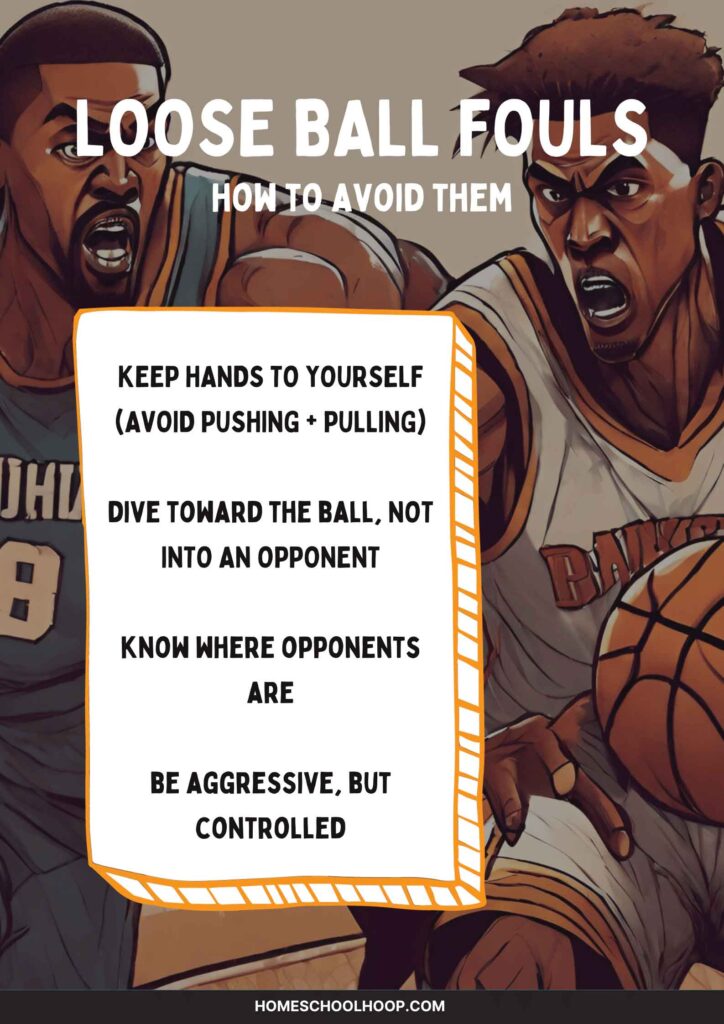A loose ball foul in basketball arises pretty often, so it is a rule that players and fans should understand. This guide aims to clarify what a loose ball is, why it matters, and how it’s handled during a game.
Key Takeaways:
- A loose ball foul occurs when players make illegal contact trying to get the ball that no one controls.
- This type of foul can give the other team free throws, which can shift the game’s momentum.
- Understanding positioning and timing can help players avoid making these fouls.
We’ll start by answering a fundamental question: What is a loose ball foul? You’ll discover the basic rules of a loose ball foul and learn how to identify, react to, and prevent these fouls during a basketball game.
Definition of a Loose Ball Foul
A loose ball foul in basketball is a type of foul that happens when a player makes illegal contact with another while the ball isn’t being controlled by anyone.

Let’s break it down. Imagine a moment in a basketball game where the ball is up for grabs – like after a missed shot, a pass that got deflected, or if the ball slips out of someone’s hands. This is called a loose ball situation because no player or team is in control of the ball. Unlike when a player is dribbling, passing, or getting ready to shoot, a loose ball is anyone’s chance to take possession.
A loose ball foul occurs in the heat of these scramble moments. When players from different teams are both going for the ball, any illegal physical contact – like pushing, grabbing, or hitting – is called a loose ball foul. The reason it’s a foul is simple: it prevents a fair chance for players to get the ball.
What is a Loose Ball Foul in the NBA?
Loose ball fouls are a regular occurrence in the NBA, which the league describes as, “A personal foul, which is neither a punching or flagrant, committed while there is no team control.”
The WNBA’s rules on loose ball fouls mirror those of the NBA.
NBA and WNBA Rules on Loose Ball Fouls:
Here’s what happens when a loose ball foul is called in an NBA or WNBA game:
- Team and Personal Fouls: The team that commits it receives a team foul, and the specific player who fouled gets a personal foul.
- Free Throws: The player who was fouled gets one free throw. If the fouling team is already in the bonus situation, the fouled player gets an additional free throw.
- Ball Possession: After free throws, the team that was fouled takes possession of the ball at the sideline closest to where the foul occurred.
- Scoring Situations: Things get interesting if a loose ball foul by the defense is followed by a successful field goal. In this case, the fouled offensive player gets one free throw. This can lead to a three or four-point play.
- Special Cases: When a defensive loose ball foul is followed by a successful free throw, the fouled player gets another free throw. On the other hand, if the offensive team commits the foul and then scores, those points do not count.
In this example of a loose ball foul in the NBA, LeBron James of the Los Angeles Lakers is called for a foul against Taurean Prince of the Milwaukee Bucks as they both chase down a loose ball.
The NBA Video Rulebook also features an example of a loose ball foul, and explains how NBA regulations dictate it should be called.
Common Scenarios Leading to Loose Ball Fouls
Loose ball fouls in basketball are often seen during certain game situations. Here are some of the most common:
Missed Shots: Often after a shot misses the basket, players scramble to secure the rebound. In the rush, a player may push, grab, or collide with an opponent, leading to a foul.
Deflected Passes: When a pass is deflected, the ball momentarily becomes free from control. Players rushing to gain possession can inadvertently commit fouls by making illegal contact.
Ball Knocked Away: During intense defensive pressure, the ball can be knocked out of a player’s hands. Both teams then try to gain control, which can result in fouls if there’s excessive or illegal contact.
Dive for the Ball: When the ball is loose on the floor, players often dive to retrieve it. In these instances, it’s common for fouls to occur due to the physical nature of diving and scrambling for the ball.
In this first example, Ole Miss and Missouri players rush to a rebound. The Missouri player gets there first, resulting in a loose ball foul on Ole Miss.
In the example below, #1 on Illinois knocks the ball loose, and then players on both Michigan State and Illinois dive for the ball. It results in a loose ball foul called on Illinois.
Penalties
After a loose ball foul is called, certain game penalties are applied. They’re similar to other personal fouls. While basketball rules can vary by league, here’s a breakdown of typically what happens:
- Personal Foul Count: The player who commits the foul receives a personal foul. This adds to their personal foul count.
- Team Foul Penalty: Loose ball fouls contribute to the team’s total number of fouls. When a team exceeds the allowed number of team fouls in a quarter or a half (depending on the league), it leads to a bonus situation for the opposing team.
- Potential Free Throws: If the team that was fouled is in the bonus situation, they get two free throws.
- Ball Possession: If the fouled team is not in the bonus, they don’t get free throws. Instead, they are awarded possession of the ball out of bounds, close to where the player foul occurred on the court.

Learn more: How many fouls to foul out in the WNBA
Tips to Avoid Committing a Loose Ball Foul
Not all loose ball fouls are avoidable. Sometimes opponents will beat you to the ball and cause you to initiate illegal contact.
But, players need to avoid unnecessary fouls to stay in the game and avoid giving the opponent an advantage. Here are some practical game strategy tips for foul prevention:
- Keep Hands to Yourself: One of the most common ways to commit a loose ball foul is by making illegal contact with an opponent. Players should focus on reaching for the ball, not the player.
- Avoid Pushing: In the heat of the moment, it’s tempting to push or shove to get to the ball. However, this is a surefire way to get penalized.
- Dive Safely: Diving for a loose ball can lead to fouls if you take out an opponent. Aim to dive in a way that avoids colliding with others, focusing on the ball’s trajectory rather than where the opponents are.
- Be Aware of Your Positioning: Understanding where you and your opponents are on the court is crucial. Good spatial awareness helps in making smarter moves to secure the ball without fouling.
- Practice Controlled Aggressiveness: Be assertive in going after a loose ball, but this should be balanced with control. Over-aggressiveness can lead to unnecessary fouls.

Their Dangers and Impact
Loose ball fouls are in place for several player safety reasons. First, the scramble for a loose ball can lead to intense physical contact, increasing the risk of injuries. Players battling over a ball might unintentionally hurt themselves or others.
Also, what starts as a loose ball foul can escalate. The physical nature of these scrambles for the ball can lead to frustration and aggressive reactions, potentially resulting in flagrant or technical fouls.
FAQs
How does a loose ball foul work?
A loose ball foul occurs when a player makes illegal contact with an opponent while trying to gain control of the basketball that is not in any player’s possession. This results in a personal foul and can lead to free throws or a change of possession, depending on the game situation.
What is the meaning of loose ball?
A loose ball in basketball refers to a situation where the ball is not in the control of any player. This can happen after a missed shot, a deflected pass, or if the ball is knocked out of a player’s hands.
How is a loose ball foul different from other fouls?
A loose ball foul is different because it occurs specifically when the ball is not controlled by any player. Other fouls, like shooting or offensive fouls, happen during different phases of the game, such as when a shot is being taken or when a player is controlling the ball.
Can a loose ball foul result in a technical or flagrant foul?
A loose ball foul is a regular personal foul. However, if the contact is excessively harsh or unsportsmanlike, it can be upgraded to a technical or flagrant foul, depending on the severity and intent.
How do referees determine a loose ball foul?
Referees look for illegal physical contact during a loose ball situation. This includes pushing, holding, or hitting an opponent. The decision is based on whether the contact disrupts a fair attempt to gain control of the ball.


